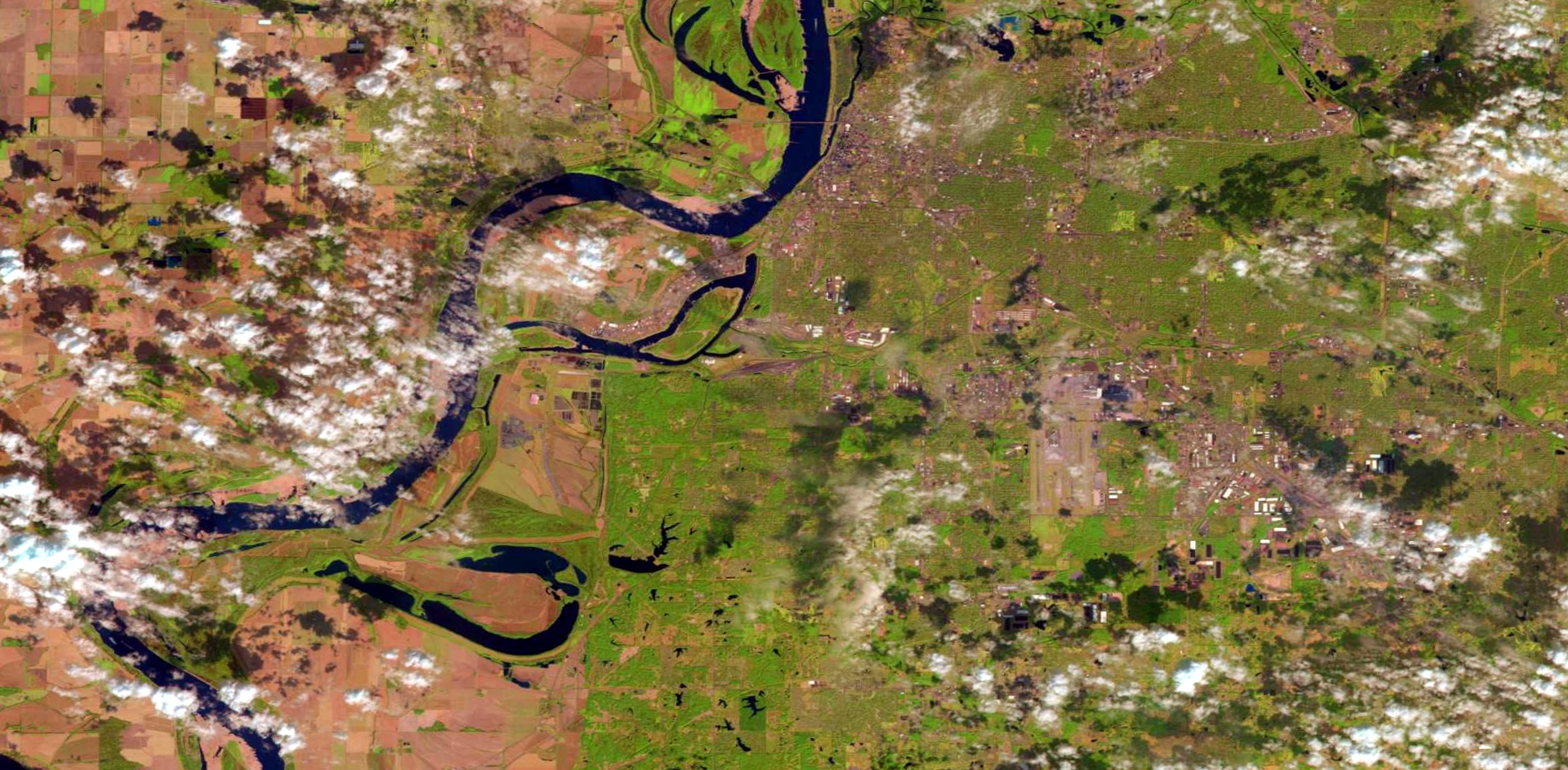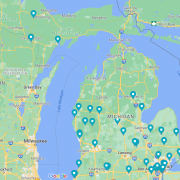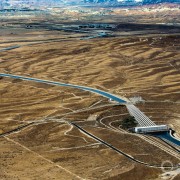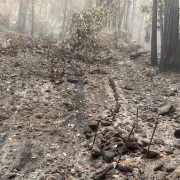Mississippi’s Claim That Tennessee Is Stealing Groundwater Is A Supreme Court First
A dispute over an aquifer that crosses political boundaries could expand water rights law.

The Sparta-Memphis Sand Aquifer lies beneath Mississippi and Tennessee, land east of the Mississippi River that is shown in this Landsat image. Mississippi’s lawsuit against Tennessee is the first lawsuit over a shared aquifer to be heard by the U.S. Supreme Court.
By Brett Walton, Circle of Blue
Sometime in the next few months, lawyers for the state of Mississippi will stand before a U.S. Supreme Court-appointed legal expert, clear their throats, and argue that Tennessee, a neighbor, is stealing water.
However it is decided, the courtroom tussle breaks new legal ground and more. It is the first time the Supreme Court has considered a lawsuit that involves the use and distribution of groundwater reserves that lie beneath multiple state boundaries. Dozens of major aquifers cross state borders. None, though, is subjected to the well-established legal instruments for allocating water that rivers are.
The discord between two southern states also illustrates how in an era of droughts, storms, and other hydrological disturbances risks to stable water supplies have steadily risen as prominent health and economic priorities in the United States. Law experts say that the case foreshadows a new field of play for water rights in the United States.
Mississippi claims that the city of Memphis is pumping so intensively from the Sparta-Memphis Sand Aquifer, which extends across state lines, that a depression in the water table has formed beneath the city’s wells and is altering the direction water moves underground. Water from Mississippi is flowing into that bowl, the lawyers will say, and Mississippi wants $US 615 million in compensation for the loss.
Tennessee, of course, disputes Mississippi’s interpretation of the aquifer’s hydrology and the laws that should apply to its use. The state has a crowd of supporters in its corner, including the federal government, which maintains that the case should be thrown out because, among other arguments, the states have no agreement that defines their share of the water.
These circumstances expose a mismatch between the way water behaves and the policies that govern it. Mississippi and Tennessee share an aquifer — water-use decisions on one side of the political border affect water availability on the other — but they do not share a system of management and oversight.
This is typical. None of the seven water policy experts that Circle of Blue contacted for this article could identify an interstate groundwater basin that is managed according to an enforceable legal agreement between states. Less formal mechanisms — discussions among managers, data sharing arrangement, and collaborative groups — exist, but they vary in their breadth and depth. The most active are in the Palouse and Spokane basins on the Idaho-Washington border.
The cross-border consequences of disjointed management go far beyond water supply for cities or farms. Pump too much from the wrong type of soil and the land can sink and water storage capacity is diminished, as is happening in southeastern Virginia near the North Carolina border. Pump too much from the coast and saltwater begins to spoil the fresh water, which is the case on the Georgia-South Carolina border. In areas where groundwater feeds springs, ecosystems can dry up. That is a fear in the Snake Valley, shared by Nevada and Utah.
New demands on groundwater require a change in regulatory approach, argues Noah Hall, an associate professor at Wayne State University Law School who studies water law.
“Groundwater is not stationary, it moves and flows, often across state lines,” Hall told Circle of Blue. “We can’t treat it like the property of any single state. Instead, we need to manage groundwater sustainably across political lines, as we’ve begun to do with surface waters.”
Management Systems Play Catchup
Surface waters, or rivers and lakes, have long been the source of legal dispute and grand bargains. The states in the Colorado River Basin were the first to sign an interstate compact, when they divided the river’s waters in 1922. More than two dozen such river compacts are now in effect. A few of these, notably in the Republican River Basin of Colorado, Kansas, and Nebraska, address groundwater that flows into rivers. The U.S. Supreme Court has heard several groundwater-surface water cases in recent years, including the Republican River and the Rio Grande, in New Mexico and Texas.

Memphis pumps roughly 140 million gallons of groundwater a day to serve a metro area of one million people. Photo courtesy of Flickr/Creative Commons user seandavis
Unlike rivers, groundwater management is still provincial. U.S. water law recognizes state authority over groundwater. As a result, states have evolved unique regulatory systems that generally do not match their neighbor’s. Scott Kudlas, director of the Office of Water Supply at the Virginia Department of Environmental Quality, told Circle of Blue that different regulatory approaches inhibit coordination with North Carolina. Virginia uses computer models to project the consequences of new well permits, whereas North Carolina relies on well measurements and has no permitting requirements, save for wells within a 15-county “critical” area that is under mandatory water-use reductions.
“In some ways that has limited the level of interstate management,” Kudlas said.
In other cases, states may not know enough about cross-border flows to begin regulating. Wyoming, in its most recent water development plan, published in 2007, notes that “groundwater enters and leaves the state in the subsurface, but no estimates of rates or locations have been compiled.”
A further complication is that groundwater oversight within a state is often split among authorities — departments of agriculture, environment, health, and water resources all might have an oversight role. “Groundwater regulation is a tough beast to get your arms around,” Don Yates of the Groundwater Protection Council, an organization of state regulatory agencies, told Circle of Blue. “There are multiple agencies in each state. There’s no groundwater czar.”
North Carolina and Virginia are good examples of the difficulty in aligning groundwater management systems. They share the Potomac Aquifer, which slopes eastward from the Piedmont to the Atlantic coast. A U.S. Geological Survey study published in August showed “substantial” water level declines of nearly 200 feet in the aquifer in southeastern Virginia over the last century. Those declines extend into northeastern North Carolina and are largely attributed to industrial groundwater use at a paper mill — shuttered in 2010 and now reopened — near Franklin, Virginia.
“It’s one continuous aquifer,” John Masterson, a U.S. Geological Survey hydrologist who worked on the study, told Circle of Blue. “There’s no reason state boundaries have an effect on how the system responds.”
The dynamic at play in the Mississippi-Tennessee case — a “cone of depression” that is drawing groundwater from one state to another — is also present in the Potomac Aquifer. North Carolina officials know this.
“It’s well-known that it’s occurring,” Nat Wilson, head of the groundwater management branch at the North Carolina Department of Environmental Quality, told Circle of Blue. Fortunately for North Carolina the drawdown within its borders is occurring in a sparsely populated part of the state. “Had there been larger users there we would have had more problems,” Wilson surmised.
Wilson said that he has informal talks with his Virginia counterparts, who share aquifer data with his office. If the states wanted to lift interstate groundwater into official business, Wilson mentioned the Roanoke River Bi-state Commission. The commission handles matters related to the Roanoke River, which crosses state lines, but its mandate could expand to address groundwater, Wilson thought. It’s the “perfect forum,” he said.
But even an existing forum might not be enough in some cases. States need an incentive to come to the table and negotiate before small issues become big problems. In northeastern North Carolina, demographic and economic trends have not collided with enough force to prompt a water-sharing agreement with Virginia. This is where the implications of Mississippi v. Tennessee could be far-reaching, according to Hall, the law professor who is closely watching the case. It could set a precedent that changes the rules of the game for interstate groundwater in the United States
Implications of Mississippi v. Tennessee
There are several outcomes for the lawsuit. If the Supreme Court sides with Mississippi’s claim that the water in the aquifer is the sole property of Mississippi, it would upend established U.S. water law. “It gets crazy,” Hall said. Such a ruling would usher in a “pay for pumping” model in which states would charge their neighbors for water use. In Hall’s opinion, this is the less likely outcome. Others agree. The solicitor general, who argues on behalf of the federal government, filed a brief strongly opposing Mississippi’s ownership claims, and lower courts have supported Tennessee.
The court could also rule in favor of Tennessee, deciding that the aquifer is subject to “equitable apportionment.” This means that the water must be shared. It is the model for interstate rivers but the Supreme Court has not yet applied it to groundwater. This ruling would nudge the states to action. Not wanting the court to divide the water, states would have an incentive to negotiate water-sharing compacts, just as they do for surface waters, Hall said.
In effect, it would be a new day for groundwater law. Nevada and Utah nearly became the first to sign an agreement for joint management of a shared aquifer system, the Snake Valley, but Utah’s governor backed out in 2013 due to political pressure. The shape that other agreements would take is unknown, but Hall argues that interstate compacts for groundwater offer an opportunity for cooperation and more thoughtful management at a time when groundwater resources are under increasing stress.
“We have a chance to avoid the mistakes of the past, when states competed to use up a resource,” Hall said. “With advances in hydrology and other sciences, we can craft modern interstate agreements that avoid conflict and protect groundwater for future generations.”
Brett writes about agriculture, energy, infrastructure, and the politics and economics of water in the United States. He also writes the Federal Water Tap, Circle of Blue’s weekly digest of U.S. government water news. He is the winner of two Society of Environmental Journalists reporting awards, one of the top honors in American environmental journalism: first place for explanatory reporting for a series on septic system pollution in the United States(2016) and third place for beat reporting in a small market (2014). He received the Sierra Club’s Distinguished Service Award in 2018. Brett lives in Seattle, where he hikes the mountains and bakes pies. Contact Brett Walton











